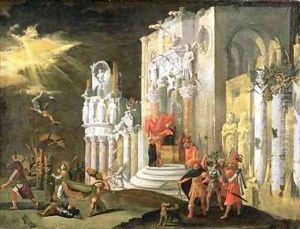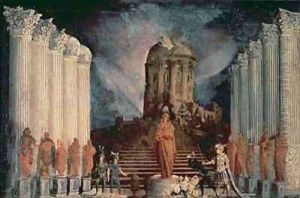Monsu Desiderio Paintings
Monsu Desiderio is not the name of a single artist, but rather an art-historical construct that refers to a group of painters who were active in Naples during the early 17th century and were responsible for a series of works featuring architectural fantasies and ruins. The name itself is a nickname meaning 'Monsieur Desire' in French and was likely adopted because of the French origin of at least one of the painters involved. The primary figures associated with this name are François de Nomé (1593–after 1640) and Didier Barra (1590–1656), although their individual contributions to works attributed to Monsu Desiderio are often difficult to distinguish.
François de Nomé was born in Metz, France, in 1593 and moved to Naples by 1602. He is known for his detailed paintings of ruins and fantastical architecture, often infused with a sense of the dramatic and the bizarre. His works typically feature classical buildings in a state of decay, with small human figures to emphasize the scale of the grand structures. De Nomé's paintings are characterized by their meticulous detail, strong use of light and shadow, and a certain eerie atmosphere that makes them distinctive.
Didier Barra, on the other hand, was also from Metz and his work often depicted cityscapes and architectural vistas. While there is less information available on Barra compared to de Nomé, it is known that he was in Naples by 1630 and that his style complemented that of de Nomé. Barra's work is characterized by its clear, bright colors and less emphasis on the ruinous and dramatic aspects that are prominent in de Nomé's paintings.
The confusion surrounding the identity of Monsu Desiderio stems from the fact that both artists worked in Naples during the same period and their styles were similar enough that for many years, art historians had difficulty distinguishing between their works. In some cases, it is believed that de Nomé and Barra might have collaborated on the same pieces, further complicating attribution.
The works attributed to Monsu Desiderio have been influential in the development of the capriccio genre, which involves architectural fantasies that combine real and imaginary elements. The haunting quality of their paintings has captured the imagination of viewers and has been seen as a precursor to the Romantic fascination with ruins and the sublime. Despite the enigmatic nature of their partnership and the challenges in attribution, the paintings associated with Monsu Desiderio remain an important part of the Baroque period in Italian art, reflecting a unique blend of French and Italian artistic traditions.

